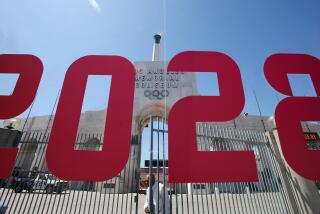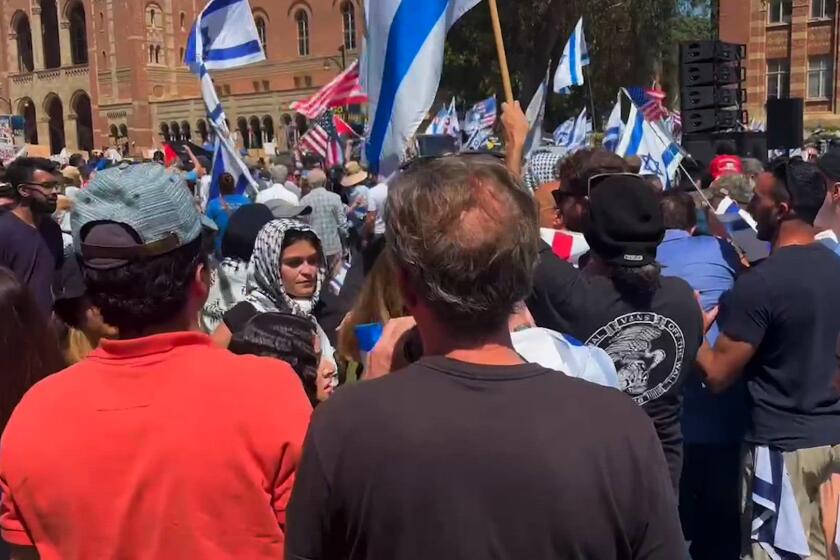Construction of Expo Line’s second part to begin
Los Angeles transportation officials readily admit that building the first phase of the Expo Line has been trying, costing hundreds of millions of dollars more than originally budgeted and suffering nagging delays.
But city and county leaders hope to leave those problems behind when they gather in Santa Monica on Monday to mark the start of construction of the second phase of the rail line — the first to reach far into the traffic-clogged Westside since trolleys ran some 50 years ago.
“Phase 1 was overly tough … over the top,” said Rick Thorpe, executive director of the authority in charge of building the Expo Line. “Phase 2 I feel much, much better about. We’re off to a great start, we’re incorporating a lot of lessons learned.”
Construction on the first phase of the line — which promises to take commuters 8.6 miles from downtown Los Angeles to Culver City in 30 minutes — began in 2006 with a price tag of $640 million, but that eventually jumped to $932 million. The second phase has a budget of $1.5 billion and will continue 6.6 miles west to the intersection of Colorado Avenue and 4th Street in downtown Santa Monica. Officials hope to have the full line open in 2015.
Thorpe attributed the first-phase budget changes to dramatic increases in construction and material costs, added expenses for new stations and grade separations, and legal battles with the project’s contractor and some local residents, among other reasons.
Last spring, officials hoped to at least open a shortened version of Phase 1 — from the 7th and Metro Center station downtown to the intersection of La Cienega and Jefferson boulevards just east of Culver City — in November.
That opening got pushed back, and now the goal is to open the shortened version by the end of the year, with the remaining 0.7-mile segment scheduled to begin operation in early 2012.
“Metro continues to run test trains and conduct system checks and will soon be training its operators and controllers on the new light rail line,” Mayor Antonio Villaraigosa said in a statement last week. “We won’t open it before Metro decides it’s fully ready.”
But even the newest targets are shaky, and Thorpe is unwilling to make promises. He said crews have “unfortunately run into some problems during the testing,” including issues with ventilation and train control software used to help connect the Expo and Blue lines.
Thorpe said the Expo Line’s second phase would involve a new group of contractors, a fixed budget and a larger contingency fund for unknown costs.
He conceded that there probably would still be problems, including legal opposition expected from a neighborhood group in Cheviot Hills. But, he said, “we’re set up in a way that we’ve got a good grip.”
Metro Chief Executive Art Leahy said that once the entire Expo Line is completed, its ridership could easily rival that of the heavily used Blue Line between Long Beach and downtown Los Angeles and may become one of the busiest rail lines in the country.
“This is really a next-step milestone for the promises of Measure R,” Leahy said, referring to the half-cent sales tax that voters approved in 2008 for transportation projects. Phase 2 of the Expo Line is heavily funded by Measure R, unlike the first phase, which began before the measure was passed.
Leahy said he expects the second phase to run more smoothly because of changes to the way the contract was issued and because of Metro policies that now demand increased scrutiny over project budgets.
Los Angeles County Supervisor Mark Ridley-Thomas said it is important for officials to study Phase 1, “especially lessons with regard to changes in project scope and budget, schedule delays and community relations,” according to copy of his prepared remarks for Monday’s groundbreaking.
Ridley-Thomas said the next phase of the project will hire more local workers, noting that when he joined the Expo Line construction authority, only 14% of the Phase 1 labor force included people who lived in the vicinity.
County Supervisor Zev Yaroslavsky said last week that he’s grown tired of discussing the problems encountered during Phase 1.
“Most of our projects in L.A. have gone largely without incident,” Yaroslavsky said. “The first phase of Expo had a lot of issues.… That’s an exception, it’s not the rule.”
“We’re starting a new chapter of the Expo Line,” Yaroslavsky said.
More to Read
Start your day right
Sign up for Essential California for news, features and recommendations from the L.A. Times and beyond in your inbox six days a week.
You may occasionally receive promotional content from the Los Angeles Times.






